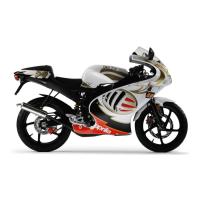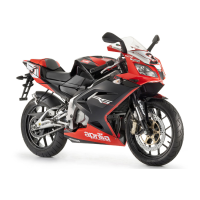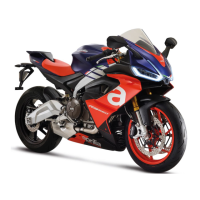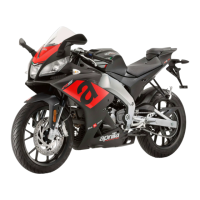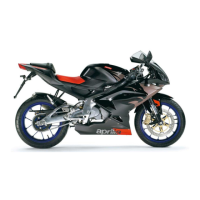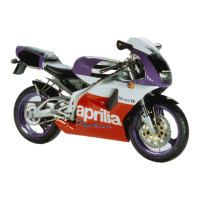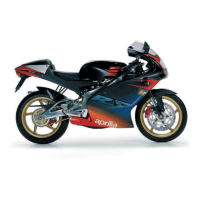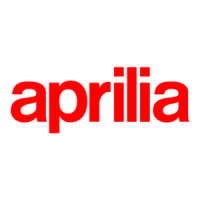
Do you have a question about the APRILIA RS 50 TUONO and is the answer not in the manual?
| Brand | APRILIA |
|---|---|
| Model | RS 50 TUONO |
| Category | Motorcycle |
| Language | English |
Explains WARNING, CAUTION, and NOTE symbols for potential hazards and important information.
Read the manual, know the vehicle, and be prepared for safe riding.
The manual is an integral part of the vehicle and must always accompany it.
Some countries require periodical inspections due to antipollution and noise regulations.
Record identification data from the SPARE PARTS IDENTIFICATION LABEL under the rider saddle.
Symbols in the manual indicate vehicle versions like OPT or catalytic.
License, age, ability, insurance, health, and substance use rules are mandatory.
Learn to ride gradually in safe areas and avoid distractions.
Follow road signs, regulations, and maintain correct riding posture.
Avoid abrupt movements, obstacles, and slipstream riding.
Focus on driving; avoid distractions from people, things, or activities.
Check fluid levels regularly and inspect for damage after accidents.
No changes endangering safety; no racing or off-road driving.
Wear homologated helmet and protective clothing at all times.
Avoid dangerous pocket items; owner responsible for accessory choice and installation.
Avoid accessories impairing function, controls, or stability; no electrical modifications.
Load luggage centrally, distribute uniformly, and secure firmly.
Avoid bulky items on handlebars; secure helmet hanging from string.
Secure bags tightly, avoid protrusions, and do not exceed maximum load.
List of numbered components shown in the main elements diagram.
List of numbered instruments and controls shown in the diagram.
List of numbered instruments and indicators shown in the diagram.
Explains horn, turn signals, dimmer switch, and cold start lever functions.
Explains the function of the starter button for engine ignition.
Describes the ignition switch positions and its functions.
Explains how to lock/unlock steering and associated safety warnings.
Location and contents of the glove/tool kit compartment.
Function and usefulness of the rear mudguard extension for spray reduction.
Fuel type, refuelling safety, and tank capacity details.
Checking and changing transmission oil, including type and intervals.
Importance of brakes, fluid type, and checking pad wear.
Procedure to check the front brake fluid level with the vehicle on a stand.
Steps for topping up front brake fluid, including checks and cautions.
Procedure to check the rear brake fluid level with the vehicle on a stand.
Steps for topping up rear brake fluid, including checks and cautions.
Topping up 2-stroke oil, reserve indicator, and engine damage warnings.
Procedure for adjusting the gear shifting lever's position.
How to adjust the clutch for correct operation and idle stroke.
Coolant level checking, safety precautions, and maintenance.
Coolant composition, ideal mixture, and seasonal advice.
Procedure for checking and topping up the coolant level.
Tyre pressure, wear, maintenance, and replacement guidelines.
Safety warnings regarding the hot catalytic silencer and avoiding leaded petrol.
Emphasizes performing preliminary checks before every ride for safety.
Table detailing essential checks before riding the vehicle.
Step-by-step guide for starting, with warnings on exhaust gases and stability.
Cautions regarding battery, oil light, and starter protection.
Procedure to clear a flooded engine using throttle and starter.
Steps for starting a cold engine using the cold start lever and throttle.
Procedure for starting the engine after a period of disuse.
Instructions for departure, passenger use, and warnings on abrupt starts.
Advice on using rear-view mirrors and understanding their wide-angle view.
Procedure for shifting into second gear and subsequent upshifts.
Steps for downshifting, including when and how to do it safely.
Control throttle, use both brakes, slow for turns, avoid abrupt actions.
Watch road, use indicators, drive cautiously in rain, avoid obstacles.
Guidelines for the initial period of vehicle use for proper component bedding-in.
Procedures for stopping the vehicle safely, including gear selection.
Instructions for parking safely on firm, flat ground, and securing the vehicle.
Steps to safely stop the vehicle, turn off ignition, and lock steering.
How to correctly place the vehicle on its stand, ensuring stability.
Tips to prevent vehicle theft: use locks, park securely, use anti-theft devices.
Warnings on fire risk, hot parts, ventilation, and handling mechanical parts.
Routine tasks by user; specific tasks require dealer assistance.
Clarifies which maintenance tasks can be performed by the user.
Explains the symbols used in the service intervals chart for operations.
Importance of frame and engine numbers for parts and legal compliance.
Instructions for placing the vehicle on a front support stand.
Procedure to check the transmission oil level with the vehicle on firm ground.
Steps for topping up transmission oil, including checks and cautions.
Steps for removing the front wheel, including caliper removal and wheel pin loosening.
Warnings about vehicle stability and brake caliper handling during disassembly.
Steps for reassembling the front wheel, including lubrication and torque.
Cautions on components, alignment, and post-reassembly system checks.
Steps for removing the rear wheel, including nut removal and chain management.
Cautions regarding wheel disassembly, brake pipes, discs, and pads.
Steps for reassembling the rear wheel, including spacers and caliper alignment.
Cautions on spacer placement, caliper alignment, and post-reassembly checks.
Procedure to check the chain slack and ensure it is within specifications.
Cautions regarding chain maintenance, lubrication, and seized links.
Steps for adjusting the chain tension and wheel centering.
How to check for wear and damage on the chain, pinion, and crown.
Guidelines for cleaning and lubricating the drive chain.
Instructions for removing and reassembling the rider's saddle.
Procedure for removing the sump guard, with cautions about plastic components.
Instructions for removing side fairings, with cautions about plastic components.
Steps to remove and clean the air cleaner element using proper solvents.
Procedure for removing the exhaust silencer and terminal, with safety warnings.
Instructions for removing the front fairing, including wiring disconnection.
Cautions regarding screw tightening on plastic and handling components.
How to inspect suspension systems for proper function and wear.
Advice on front fork oil service and contacting a dealer for irregularities.
Procedure for visually checking brake pad wear and replacement intervals.
Warnings about excessive wear affecting braking efficiency and disc integrity.
How to adjust the engine idling speed for smooth operation.
How to adjust the throttle grip's idle stroke for proper response.
Procedures for cleaning, checking gap, and replacing the spark plug.
Cautions regarding spark plug tightening and using the correct type.
Information on battery maintenance, electrolyte level, and safety precautions.
Recommendations for battery care during long periods of vehicle inactivity.
How to check, clean, and protect battery and cable terminals.
Step-by-step guide for safely removing the battery from its compartment.
Procedure to check the electrolyte level, with topping-up instructions.
How to recharge the battery, including amperage recommendations and safety.
Steps for correctly installing the battery after servicing or recharging.
How to check and replace a blown fuse, with warnings about correct types.
Describes the fuse arrangement and its connection to electrical loads.
Instructions for cleaning the exhaust silencer and terminal, with safety warnings.
How to check the side stand's condition and ensure it rotates freely.
How to check the stoplight switches and their connections for proper operation.
Procedure for adjusting the headlight beam's vertical position using screws.
Cautions regarding handling plastic components and reassembly of the inner cover.
General precautions for changing bulbs, including handling and cleaning.
Step-by-step guide to changing headlight bulbs, including parking light bulb.
Specific instructions for extracting and replacing the parking light bulb socket.
Instructions for removing and replacing high beam bulb sockets.
Instructions for removing and replacing low beam bulb sockets.
Procedure for changing front and rear direction indicator bulbs.
Steps to completely drain the fuel tank and carburettor for transport.
Warnings on brake function impairment after washing and cleaning methods.
Procedure for cleaning painted surfaces using low-pressure water and shampoo.
Necessary precautions and checks for storing the vehicle for extended periods.
Steps to take after removing the vehicle from storage, including cleaning and checks.
Details on transmission type and gear ratios.
Carburettor model and fuel supply type and octane recommendations.
Tyre pressures, ignition type, and spark plug details.
Specifications for battery, fuses, generator, bulbs, and warning lights.
List of recommended lubricants for various vehicle components.
Warnings about using new brake fluid and mixing oils.
Highlights expertise of Aprilia network engineers and importance of original parts.
Key explaining components and numbering used in the wiring diagram.
Key listing cable colours and their corresponding names.
